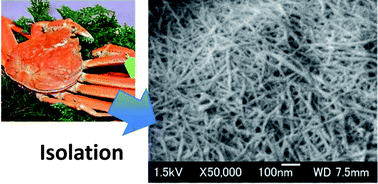Chitin nanofibers: preparations, modifications, and applications
Abstract

* Corresponding authors
a
Department of Chemistry and Biotechnology, Tottori University, Tottori 680-8552, Japan
E-mail:
sifuku@chem.tottori-u.ac.jp
Fax: +81 857 31 5592
Tel: +81 857 31 5592

 Please wait while we load your content...
Something went wrong. Try again?
Please wait while we load your content...
Something went wrong. Try again?
S. Ifuku and H. Saimoto, Nanoscale, 2012, 4, 3308 DOI: 10.1039/C2NR30383C
This article is licensed under a Creative Commons Attribution 3.0 Unported Licence. You can use material from this article in other publications without requesting further permissions from the RSC, provided that the correct acknowledgement is given.
Read more about how to correctly acknowledge RSC content.
 Fetching data from CrossRef.
Fetching data from CrossRef.
This may take some time to load.
Loading related content
